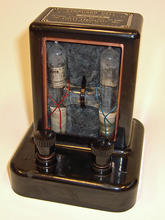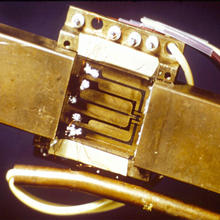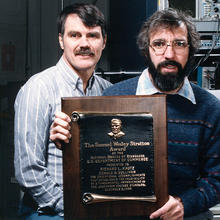1970s - History of NIST Quantum Voltage Standards
1972
At one time the best standards for voltage were electrochemical cells. But no matter how carefully such cells were fabricated, their voltages inevitably drifted from month to month. In July 1972, the United States redefined its working volt in terms of the Josephson effect, predicted in 1962 by Brian Josephson, a graduate student at the University of Cambridge in the United Kingdom.
A Josephson junction is a sandwich of superconducting materials separated by an atomically thin insulating or resistive film. When microwave radiation of a known frequency is applied, the junction generates an accurate voltage that is exactly proportional to the frequency and two fundamental constants of nature.

1973
Based on pioneering work at the University of Pennsylvania, a NIST group developed a four-junction array and measurement methods for using it as a voltage standard. Mounted in a 25-millimeter-wide waveguide, the device was large and crude by modern standards and more challenging to adjust. But it enabled researchers to maintain the U.S. legal volt by operating two junctions in series and comparing the 10-millivolt output to the 1-volt electrochemical cells.
(Citation: B. F. Field, T. F. Finnegan, and J. Toots. 1973. Volt Maintenance at NBS via 2e/h: A New Definition of the NBS Volt. Metrologia 9, 155-166)

1977
Don Sullivan of NIST and Mogens Levinsen of the University of Copenhagen had a brainstorm leading to the concept for the first practical Josephson voltage standards. A single Josephson junction produces no more than about 0.005 volt. The junction's small voltage and thermal voltages in the leads connecting it to room temperature combined to limit the accuracy of the early volt standards. Metrologists wondered if they could connect several junctions in series to make a larger voltage, just as a 12-volt car battery is made up of six 2-volt cells.
Sullivan and Levinsen realized that if junctions of a certain type were connected together willy-nilly and stimulated with a microwave signal (leaving the junctions "biased" near zero current), then the induced voltage would necessarily be quantized. This eliminated the need to carefully adjust the current flowing through each junction and proved to be a simple and practical way to obtain larger voltages.


